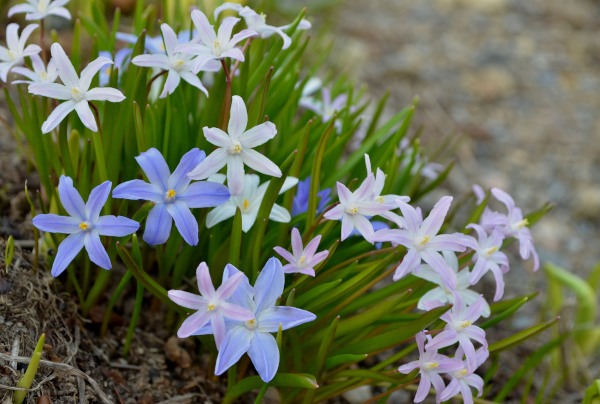How to grow Chionodoxa
Chionodoxa is a small genus of hardy, bulbous perennials belonging to the same family as scilla and hyacinth, native to mountains and open forest in Crete, Turkey, and Cyprus. Also known as ‘glory of the snow’, it is one of the first bulbs to flower in spring – its delicate, star-shaped blooms bursting open to reveal a distinctive white eye. The flowers are often blue, though pink and white forms are also available. As bulbs go, the foliage to flower ratio is good – just two leaves for every flowering stem, meaning the blooms stand out nicely.
Chionodoxa is a good choice for naturalising in the ground beneath deciduous trees and shrubs, spreading by both seed and bulb offset. It is also especially well-suited to growing in grass; its earliness means the foliage has usually died back in time for the first mow of the year, unlike many other spring bulbs for which this must be delayed.
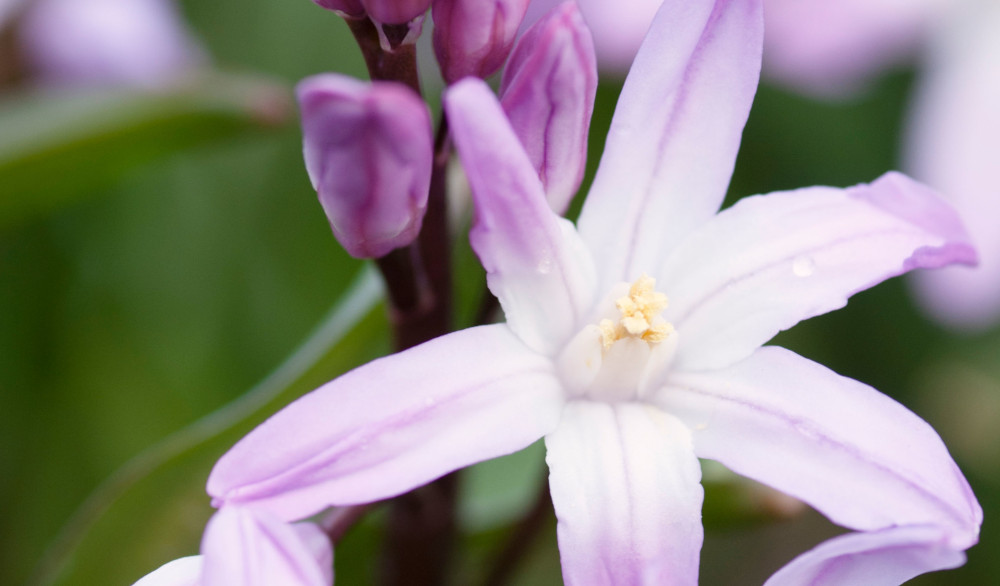
Key Information
Soil pH
Position
Hardiness


Where & when to plant Chionodoxa
Position - One which receives full sun in spring and early summer (it is fine for this to become shaded out by trees or shrubs as the season progresses).
Soil - Any well-drained soil
Flowering Period - Early spring
Hardiness - Fully hardy, usually rated H6, i.e., hardy to between -15°C and -20°C.
Spring flowering bulbs such as chionodoxa should be planted in autumn, on a day when the ground is not frozen or waterlogged.
For maximum impact, plant large groups of chionodoxa in turf or the ground beneath deciduous trees and shrubs. Alternatively, grow a small number in a pot or trough to encourage close admiration of their delicacy, or weave through a border to fill the gaps between perennials. As an early source of nectar, chionodoxa makes a valuable inclusion in a pollinator-friendly scheme.
How to plant Chionodoxa
For planting into the ground, start by digging the soil area over, removing any large stones and weeds and breaking up any lumps. Rake level and firm with your heels. Rake level again.
For a naturalistic drift, scatter bulbs onto the ground and plant wherever they land, repositioning slightly if any bulbs are too close (i.e., less than 4-5cm apart). For each bulb, dig a small planting hole deep enough that the top of the bulb sits 4-8cm beneath the surface of the soil. Place the bulb in the hole (pointy side up). Backfill with soil and firm in gently. Soak well with water.
For planting into turf, either plant each bulb individually by scattering a handful onto the ground, then wherever they land use a sharp stick or implement to create a small hole. Aim for the top of the bulb to sit 4-8cm beneath the surface of the soil, and a spacing of at least 4-5cm between each bulb.
Alternatively, you can lift sections of turf to allow multiple bulbs to be planted at once. Use a sharp spade to cut the letter H into the turf, peel back the two flaps, and scatter a handful of bulbs onto the revealed soil. Tweak each bulb to make sure the pointy end is facing up, then put the turf flaps back in place and firm in gently. Aim for around 15 bulbs per 30cm square. Use compost or soil to fill or level off any gaps. Soak well with water.
For planting in containers, first choose an appropriately sized pot. Like all bulbs, chionodoxa can be planted more closely together in a pot than in the ground. Always ensure there are plenty of drainage holes in the bottom.
If you are using a large or heavy pot, it can be a good idea to fill and plant it in situ to save yourself the trouble of moving once full.
Use a good quality potting compost with plenty of horticultural grit mixed in, and, if not already present in the compost (check the description on the bag) some slow-release fertiliser granules.
Start by partially filling the pot with compost; enough so that when placed on it the tips of the bulbs are about 10cm beneath the top of the pot.
Top with more compost, leaving a couple of centimetres gap below the top of the pot.
Pick up the pot (if you can!) and lightly tap on the potting bench or ground a few times to help further settle the compost around the plant. Soak well with water.
A mulch with horticultural grit will look attractive and help to prevent a ‘cap’ or crust forming on the top of the compost (something container plants can suffer due to the artificial nature of their watering). It also keeps the flowers clean as they emerge and prevents blackbirds tossing the compost about.
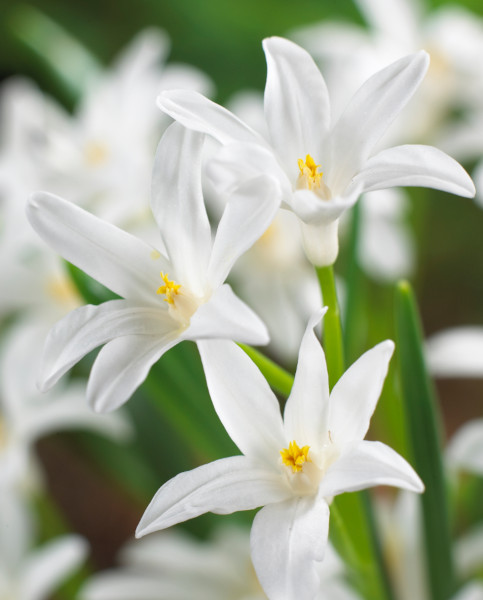
What to plant with Chionodoxa
A large drift of Chionodoxa is hard to beat, they almost seem to sparkle. But if you have not got the room, they excel when planted in clumps. Being quite short, make sure you do not overshadow them with taller bulbs. The perfect companions would be small Daffodils like Rip Van Winkle, a bright double bloom to really highlight your Chionodoxa, or Crocus and Muscari Grape Hyacinths.
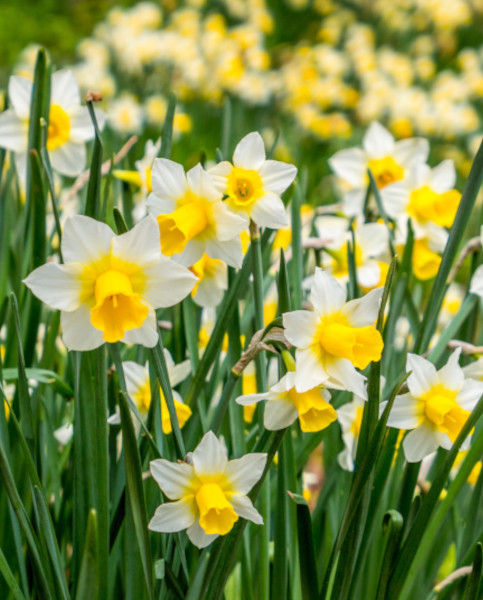
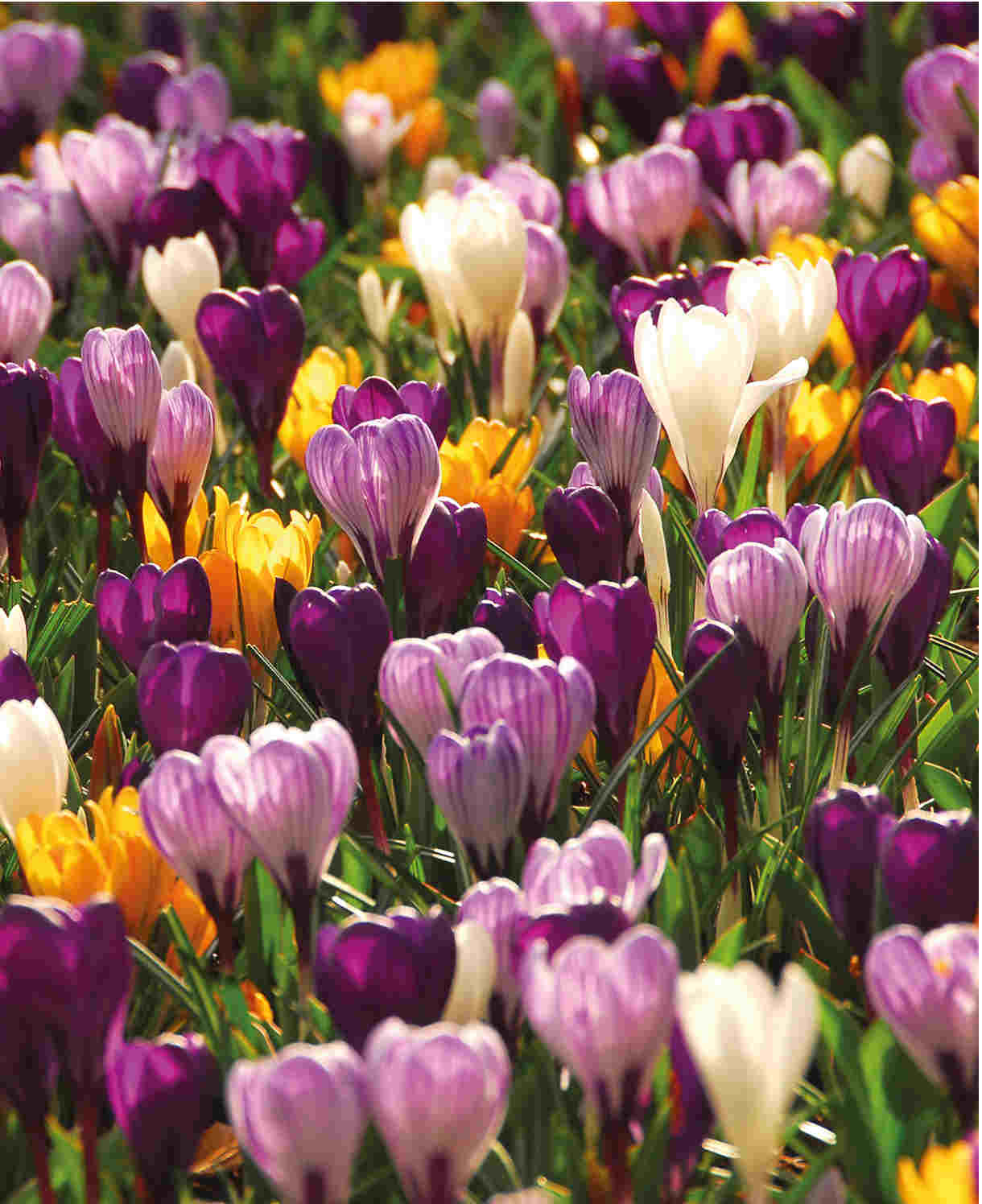
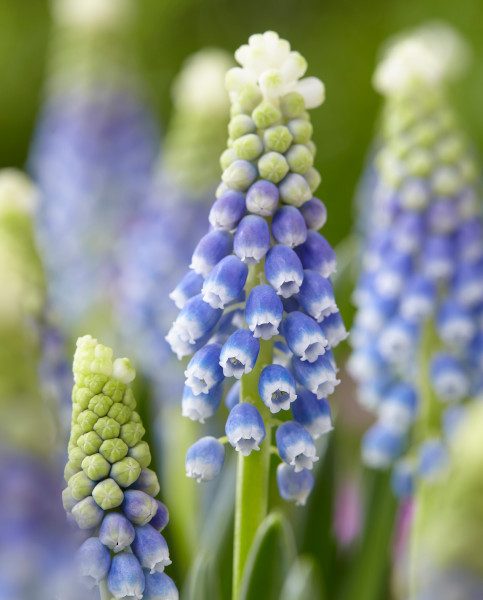
How to care for Chionodoxa
Pruning and Deadheading
Like many bulbs, chionodoxa is best left untouched and should be allowed to die back naturally. Leaving spent flowers intact enables seeds to spread and form naturalised swathes. Resisting the urge to cut back foliage is even more important, as the process of yellowing and dying back is crucial in boosting the bulb’s energy reserves for the following year. So if grown in grass, resist the urge to mow for a while
Watering
After their initial soaking, chionodoxa bulbs in the ground should not require any additional watering. In a container, keep the compost moist but not soggy throughout winter and spring. Stop watering when the foliage dies down (this allows the bulbs to enter summer dormancy).
Feeding
On healthy, fertile soil, chionodoxa shouldn’t require feeding.
Container-grown plants are different as they rely solely on the gardener for nutrition. Get off to a flying start by making sure you use a good quality compost with slow-release granules mixed in. Then, when the bulbs are in active growth, add a liquid fertiliser to the can whenever you water (a high potash feed such as tomato feed is ideal).
Cold Protection
Chionodoxa is fully hardy and able to withstand a UK winter without the need for additional protection.
Pests and Diseases
Chionodoxa is considered problem-free.
How to propagate Chionodoxa
Either collect and sow seed or pot up bulb offsets in summer. Both methods will take several years to reach flowering maturity.
Seed:
- Seeds are typically ready for collecting in mid to late spring when the seedheads are dried and brown.
- Snip the seedheads from the plant using scissors or secateurs. Try to do this in dry conditions, and shake the seeds into a small, labelled paper bag or envelope.
- Fill a seed tray or small pot with a well-draining compost mix, compressing the surface lightly with a flat piece of wood or the bottom of another pot.
- Sprinkle the seeds evenly over the surface of the compost.
- Use a garden sieve to cover with a fine layer of compost.
- Water the soil gently with a fine spray until it is evenly moist but not waterlogged.
- Place the seed tray or pots in a coldframe if you have one, or anywhere cool and protected if not. Keep shaded and don’t allow the compost to dry out until the seedlings have germinated and died back naturally.
- Expect to pot these up in their second year. Tip out the seedlings and separate into clumps of 4 or 5, putting each in a new pot. Water and return to the coldframe. Again, keep moist during the growing season.
- Bulbs should be big enough to be planted out in year three or four.
Bulb:
- Once you are certain your chionodoxa is dormant (indicated by withered, yellow foliage), carefully use a fork to lift a clump out of the ground.
- Shake and rub off any soil.
- Gently tease away any offsets which have formed around the main bulb.
- Place the offsets in a cool, dry place for a few weeks to allow them to fully dry out.
- Pack in a pot, tray, or box with dry compost, vermiculite, or newspaper.
- Store somewhere cool and dry such as a shed, garage, or unheated greenhouse, until ready to pot up or plant in autumn (as above in the ‘How to plant chionodoxa’ section).
* Many plants carry Plant Breeders Rights and cannot be propagated for commercial purposes.
Common Chionodoxa questions
Is chionodoxa poisonous to pets?
Chionodoxa has no toxic effects reported/
What does the name chionodoxa mean?
Chion is an ancient Greek word for snow, while doxa means glory.
Will chionodoxa naturalise?
Chionodoxa are excellent naturalisers, eventually forming beautiful drifts. As well as multiplying by producing ‘daughter’ bulbs alongside the parent bulb, they blossoms also produce seeds which can be distributed by ants.
Are chionodoxa bothered by pests?
Rodents and deer rarely bother chionodoxa bulbs.
